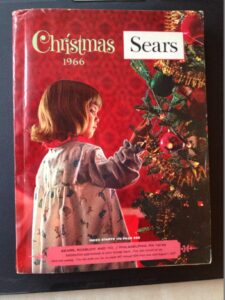
If you were a child in the 60’s or 70’s, my story is probably similar to yours. I would sit with that book for hours, using my signature colored pen (keyed for my parents as “Green = Walt”) to circle anything and everything that I’d like to find under the family tree on Christmas morning. During my younger years, I wielded my pen with reckless abandon. As I got older, I would sit under my covers with a flashlight and the catalog, secretly breaking curfew while ranking my material desires numerically and calculating prices while wondering just what “Santa” might be able to afford that year. The fruit of my labors was a neatly written and ranked list to pass on to my parents.

Then came the night before the day that would change my life. If there ever was a time when my mind was totally sidetracked during a worship service, it had to be Christmas Eve. All I could think about – besides “when are we going to sing the last hymn?”- was toys, toys, and more toys. I can still remember the excitement of getting home, ripping off my Sunday clothes, and slipping on my pajamas. We’d stay up later than usual running the HO trains, sipping on non-alcoholic eggnog, eating my Aunt’s famous Christmas cookies, snarfing down chocolates from a Whitman’s Sampler, and chewing on a piece of one of the many fruitcakes bestowed upon my pastor-father from his grateful parishioners. But the only thing in our house thicker than those fruitcakes was the excitement of those three little boys.
Bed time arrived – which was only a signal for us to take our excitement and move it from a vertical to a horizontal position. There were never any sugar plums dancing in my bedded head on Christmas Eve. Instead, my eyes remained as wide as saucers for what seemed like an eternity. And when sleep finally came, my anxious conscious thoughts of what I’d find under the tree soon yielded to unconscious dreams of the same stuff. Those wishful thoughts and dreams that had consumed me for weeks could be summed up in one thought: “Tomorrow morning, my life will be complete.”
At my house, we were usually up long before the sun on Christmas morning. It was my mom’s responsibility to repeatedly tell us to “Wait at the top of the stairs!” while my dad took what seemed like forever to set up his 8mm movie camera while shouting “Not yet!” over and over in response to our endless impatient shouts of “CAN WE COME DOWN NOW?”. When the words “Okay, now” were finally spoken, we began our trek down the steps to the living room. The descent was always somewhat hairy as the three of us were blinded by the moose antler-sized rack of heat radiating spotlights on top of my dad’s movie camera. But once we reached the bottom of the steps and our eyes adjusted, we beheld the promised land right there under the Christmas tree.

Even though I know better, I sometimes still find myself unknowingly falling back into those same old patterns. You think I would have learned by now. Maybe it’s not the stuff that appears under the Christmas tree. We don’t even get a Sears Christmas catalog anymore. Now it’s any of a number of attractive lies floating around the cultural air we all breath that are full of nothing but empty promises. Yes, the “lie of Christmas” lives on strong in our culture year-round.
Saint Anselm prayed about the “lie of Christmas” about a thousand years before I was born: “Lord, give me what you have made me want,” he prayed. “I praise and thank you for the desire that you have inspired; perfect what you have begun, and grant me what you have made me long for.” Anselm knew that the longings and desires we all experience originate in God and can only be filled by Him. He had discovered the only truth that can satisfy the hunger we all try to fill with the lie.
Six hundred years later, the French philosopher Blaise Pascal pondered the same thing: “What else does this longing and helplessness proclaim, but that there was once in each person a true happiness, of which all that now remains is the empty print and trace? We try to fill this in vain with everything around us, seeking in things that are not there the help we cannot find in those that are there. Yet none can change things, because this infinite abyss can only be filled with something that is infinite and unchanging – in other words, by God himself. God alone is our true good.”
The gnawing desire to fill Pascal’s “God-shaped vacuum” isn’t limited to kids at Christmas. It’s a daily battle for all people, of all ages, in all places in today’s culture. On a trip to Barnes & Noble, the cover of an issue of Men’s Journal caught my eye. This “10th Anniversary Special” edition of the magazine promised readers the same thing I longed for at Christmas. Inside I found “the list of a lifetime – the sixty things every man must do at least once.” The article promised male readers that by experiencing everything on this definitive list, you’d wind up living a life that’s fulfilled, peaceful, and complete. In fact, “it could be the last to-do list you’ll ever need.” After reading through the list, I realized I’m only batting a measly and less-than-manly .150 and therefore, pretty far off from experiencing complete fulfillment. The nine listed things I’ve done in my lifetime include owning a dog, watching your child arrive (truly amazing!), riding a motorcycle, acting like a kid (something some say I’m pretty consistent and good at!), building something, and planting a tree. Apparently I’ll be a miserable and unfulfilled failure until I do the 51 other things on the list including living like a king (renting a $6500 a night suite in a Hong Kong hotel), reveling in the “raw sensuality” of Rio’s Carnival, wrestling a bear, climbing Kilimanjaro, and experiencing sex with two women at once. Yes, the great “lie of Christmas” lives on in today’s culture. We believe we can fill the gnawing hunger with anything and everything but the one right thing. What a lie!
Without a doubt, the greatest inheritance we can pass on to the kids we know and love is the truth about the lie. Not only that the “lie of Christmas” is a lie, but that the “truth of Christmas” is the truth. My parents passed on that truth in many ways. But as I think back on my memories of childhood Christmas’s past, it was their Christmas lists that told the truth so clearly. Every year, when I would take a break from my selfishness to ask them what they wanted for Christmas, the answer was always the same – “We don’t need anything.” Then, when Christmas morning would arrive, I would feel bad for them as they opened boxes of socks, sweaters, tools, kitchenware, and itchy shirts – all stuff from the first two-thirds of the wish book. Much to my surprise, they were never disappointed. Why? Because they had already been satisfied by the truth of Christmas. . . . they had embraced the gift of the baby whose Birthday we were celebrating. Sure, my parents thought Christmas gifts were nice and they appreciated every one of them. But the hole in their souls had already been filled. Because they didn’t want anything, I quickly learned they already had everything.
Shortly after Blaise Pascal died, someone found a piece of paper sewn into the lining of his jacket. Pascal had placed it there as a constant reminder of what the “truth of Christmas” had meant to him when he first believed and experienced it. On the paper were recorded the words he had written when the God-shaped vacuum of his life had been filled by the baby Jesus: “From about half past ten in the evening to about half an hour after midnight. Fire. God of Abraham, God of Isaac, God of Jacob. Not the God of philosophers and scholars. Absolute Certainty. Beyond reasons. Joy. Peace. Forgetfulness of the world and everything but God. The world has not known thee, but I have known thee. Joy! Joy! Joy! Tears of Joy!”
The old man Simeon waited in great expectation for the arrival of the promised Messiah. He knew what it was he longed for. The Holy Spirit had shown him that before he died, he would see the baby Jesus. Eight days after Christ’s birth, Simeon held “the truth of Christmas” in his arms and praised God with these words: “God, you can now release your servant; release me in peace as you promised. With my eyes I’ve seen your salvation.”
While the “lie of Christmas” lives on strong, it can’t compare to the life-changing power of what Christmas is really about. This truth of Christmas is the very thing – the only thing – that answers our deepest of longings and fills the most empty of lives! Perhaps as you gather around the tree this Christmas you’ll make it your prayer that the kids you know and our culture-at-large would behold the same “glory land” that filled Simeon’s eyes and countless hearts since the day God became man.